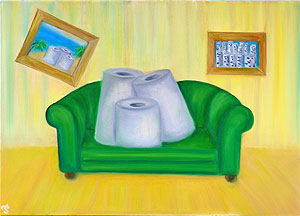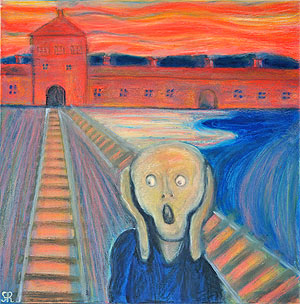Visualization of the invisible
Download PDF
Download JPG
Watch jpg
The 20th century was the century of the birth of symbols.
When looking at a pacific, a swastika or a red five-pointed star, anyone reads a
huge amount of information that would otherwise have to be written into several
books.
However, of course, symbols existed before. Suppose a crucifixion, crescent or
Star of David (Magen David). Or the coats of arms of cities, clans and royal
houses. The only difference is that it was a rather limited set of religious and
secular symbols. The first step towards symbolizing everything was made by
Delacroix in 1830. He symbolized the French revolution and freedom in his
painting.
The industrial revolution and advertising over the past two centuries have
extended symbolism to almost all aspects of human life. Seeing the three stripes
or wing strokes on sneakers, we instantly read the characteristics and quality
that were laid. Seeing the emblem on the hood, we can quite accurately imagine
the characteristics of the car. Flags, such as the United States, are also not
so much a state attribute, as a symbol, as well as a dollar sign.
In the 20th century work with the invisible permeates all aspects of human life,
from the subconscious of Freud to quantum physics or the structure of the atom.
In the visual arts of the 20th century, the same thing happened - the
visualization of the invisible, and searches for symbols for his image. This is
especially noticeable in posters and cartoons - the main visual directions of
the 20th century, after the advertisement.
And if the posters visualized some appeals, and a caricature visualized hidden
vices and thoughts, the advertisement visualized success or well-being.
And if the 20th century is the birth of symbols, then the 21st century is the
age of symbols.
One of the modern artists who have subtly felt this change is Tatiana Sokolova
(Akrolesta).
This is what the artist says: “Modern people do not want to read. They have no
time for this. They search pictures on Facebook and Instagram, watch video in
accelerated mode, advertising. Therefore, I often use the same poster colors to
attract the attention of my audience. Ironical, sometimes flashy pictures are a
kind of appeal to the human brain, the key to start the gears. ”
Let"s look at her paintings from this perspective. For example, The Journey of
brain.

We see a conditional boat in a conditional boundless sea and two human brains
that row in this boat.
Several Bulgarian media instantly used this picture for articles on brain drain,
immigrants saw themselves in this picture, and happy married couples identified
their joint travel, movement in the same direction.
And all these layers are certainly present in this painting.
The artist is well aware that this symbol is eternal. Therefore, it is not a
drawing, but a picture of a standard museum format.
And as the artist"s paintings survive on the walls of the museum, so the
problems of immigrants, the problem of brain drain, the question of creating a
happy family, when the two are rowing in one direction, are eternal. And the
artist designed these questions in the form of a symbol, thereby giving them a
philosophical coloring, fixing these questions, prompting the viewer to remain
in these questions, to talk about them.
We do not perceive the symbols consciously and seriously, reading them
semi-subconsciously. It seems to us that this is something completely trivial,
like a wheel. However, it is worth thinking about how brilliant was the person
who gave us such a wonderful thing as a wheel.
Of course, not all the artist’s symbols can be equally clear or easily readable.
Just as not everyone reads the cryptocurrency symbols or state flags, or even
symbols of international organizations. However, it is worth trying. Mixing in
her paintings the conciseness of the poster, the irony of the caricature and the
philosophy of high painting, Tatyana Sokolova visualizes a new language of the
21st century - the language of symbols.
Do we not discuss "couch potatos", do not become dependent on TV, after
returning from work, do not sit stupidly on the couch, flicking channels? And
isn"t it comfortable for us in this sofa? We are like a family on the painting
"In front of the TV (Family portrait)"by Tatiana Sokolova.

But not always the character is read so easily and simply. However, few of us
really thought about the meaning of such symbols as a crucifix or a six-pointed
star (Star of David). And even a much simpler symbolism of national flags or
trademarks is practically not reflected by us. And in vain.
Living in the era of symbols, it would be nice to understand what these symbols
mean and what is the meaning, what meanings stand behind them.
Symbolic painting is deceptively simple to understand. Take, for example,
Tatiana’s painting the Way.

What do we see here?
Crucifix? Road to the crossroads? Choosing the path? A cross that a woman has to
carry all her life in the patriarchal world? And maybe all this at once?..
And this is the strength of the symbol. It is imprinted as a stigma, and our
brain continues to analyze it for a long time after we left the museum hall.
Or look at another picture. It seems to be primitive and simple. On the image of
a shoe ("Shark-shoe").

Men hardly guess, but women know clearly to the pain that beautiful shoes are
sometimes felt by their feet as prison shoes, like Chinese princess shoes that
squeeze bones.
However, men, too, easily consider in this symbol shark requests of some women.
Another symbolic painting of Tatiana Sokolova is extremely far from any irony.
It is gloomy, like the entire 20th century. The painting is called “The
premonition of Munch (Portrait of the XX century)”.

It depicts a figure from the Edward Munch"s painting "Scream" ("Skrik"). And
although Munch himself interpreted his work differently, the artist Tatiana
Sokolova depicted a Munch"s figure ( a symbol of the 20th century) against a
different symbol - the gate of the concentration camp, the Auschwitz death camp.
The combination of horror on the face of the character with a picture of Munch
and the symbol of genocide gives a very dark and truthful portrait of the 20th
century.
And now we read these symbols as letters or words, but not as symbolic pictures.
And the artist of the 21st century is trying to invent with symbolic pictures an
artistic language understanable for everyone .
Modern art is not a product from a souvenir shop, it is the language.
Modern art is quite comparable with the fundamental science that works with the
invisible atom, viruses, or equally invisible huge black holes. Contemporary art
works with the invisible soul, with subconscious, with things that make man a
man, which distinguishes man from stone or cockroach.
And modern art is not much simpler than modern physics or philosophy. But as a
modern mobile phone or a car begins with fundamental physics, and civil
liberties and rights from fundamental philosophy, so a modern person is
imposible without understanding of modern art. Of course, if he wants to be a
man of the 21st century, and not get stuck in his development at the level of
the Middle Ages and the Inquisition.
Yan Ruskin
Magazine "Cosmo
lady", June 2018.
Woman"s Era Magazine July 2019
